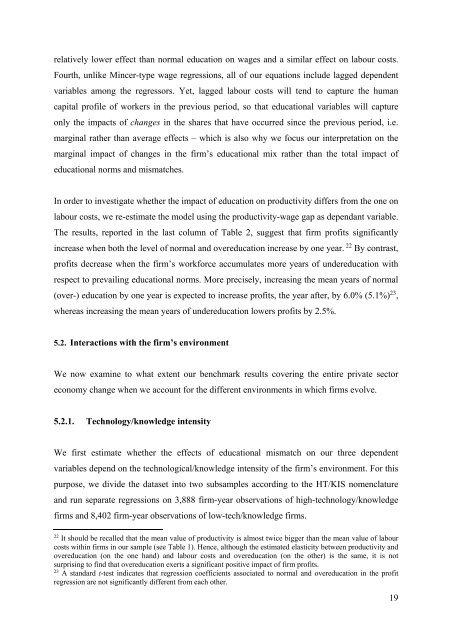CEB Working Paper
240798&r=lma
240798&r=lma
You also want an ePaper? Increase the reach of your titles
YUMPU automatically turns print PDFs into web optimized ePapers that Google loves.
elatively lower effect than normal education on wages and a similar effect on labour costs.<br />
Fourth, unlike Mincer-type wage regressions, all of our equations include lagged dependent<br />
variables among the regressors. Yet, lagged labour costs will tend to capture the human<br />
capital profile of workers in the previous period, so that educational variables will capture<br />
only the impacts of changes in the shares that have occurred since the previous period, i.e.<br />
marginal rather than average effects – which is also why we focus our interpretation on the<br />
marginal impact of changes in the firm’s educational mix rather than the total impact of<br />
educational norms and mismatches.<br />
In order to investigate whether the impact of education on productivity differs from the one on<br />
labour costs, we re-estimate the model using the productivity-wage gap as dependant variable.<br />
The results, reported in the last column of Table 2, suggest that firm profits significantly<br />
increase when both the level of normal and overeducation increase by one year. 22 By contrast,<br />
profits decrease when the firm’s workforce accumulates more years of undereducation with<br />
respect to prevailing educational norms. More precisely, increasing the mean years of normal<br />
(over-) education by one year is expected to increase profits, the year after, by 6.0% (5.1%) 23 ,<br />
whereas increasing the mean years of undereducation lowers profits by 2.5%.<br />
5.2. Interactions with the firm’s environment<br />
We now examine to what extent our benchmark results covering the entire private sector<br />
economy change when we account for the different environments in which firms evolve.<br />
5.2.1. Technology/knowledge intensity<br />
We first estimate whether the effects of educational mismatch on our three dependent<br />
variables depend on the technological/knowledge intensity of the firm’s environment. For this<br />
purpose, we divide the dataset into two subsamples according to the HT/KIS nomenclature<br />
and run separate regressions on 3,888 firm-year observations of high-technology/knowledge<br />
firms and 8,402 firm-year observations of low-tech/knowledge firms.<br />
22<br />
It should be recalled that the mean value of productivity is almost twice bigger than the mean value of labour<br />
costs within firms in our sample (see Table 1). Hence, although the estimated elasticity between productivity and<br />
overeducation (on the one hand) and labour costs and overeducation (on the other) is the same, it is not<br />
surprising to find that overeducation exerts a significant positive impact of firm profits.<br />
23<br />
A standard t-test indicates that regression coefficients associated to normal and overeducation in the profit<br />
regression are not significantly different from each other.<br />
19


